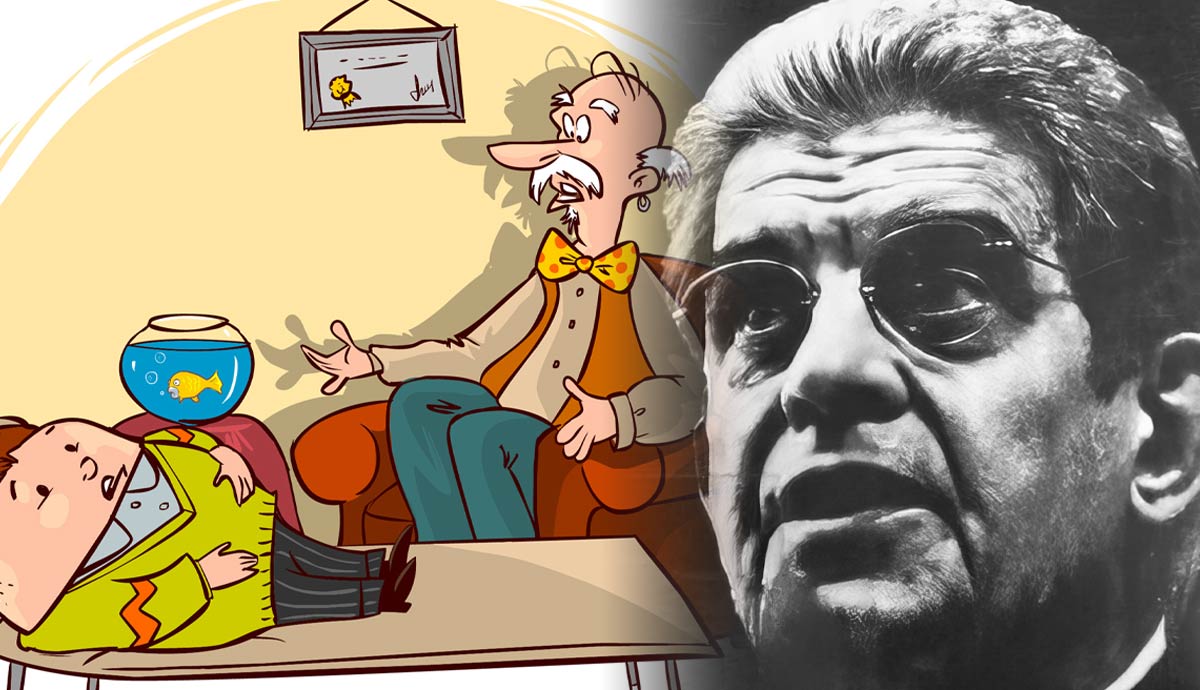
For more than a century, psychoanalysis has been the dominant therapeutic approach in psychology. Developed by Sigmund Freud, it is hard to ignore. However, the French psychoanalyst and philosopher Jacques Lacan had something of his own to say about how analysis works; he drew heavily on Freud but added a take on language and the unconscious that makes you want to hear more. So, what is Lacan’s emphasis on language and the unconscious all about—and how does it contribute to our understanding of ourselves?
Who Is Jacques Lacan?

Born in Paris, France, in 1901, Jacques Lacan was a major figure in psychoanalysis, psychiatry, and philosophy. He is one of the most influential thinkers within psychoanalysis, challenging and building on Freud’s theories.
As a student, he immersed himself in bohemian circles and became interested in surrealism and irrationality in relation to creativity. This interest led him to study medicine at the University of Paris, where he discovered Freud’s work, which had a big impact on his understanding of psychology.
After qualifying as a doctor before becoming a psychiatrist, Lacan initially stuck closely to Freudian principles: he organized seminars and psychoanalytic groups under the banner “Back to Freud,” arguing for fidelity to what he saw as the core ideas set out by the Austrian.
But as his investigation into psychoanalysis progressed, so did his ideas—much further than those of his guiding intellectual light.
Structural linguistics was key to Lacan’s insights; other major influences included Hegelian dialectics plus Jacques Derrida’s deconstruction theory.
Language, being central to human subjectivity, had an enormous bearing on how Lacan wanted to understand unconscious desires.
Lacan presented refined versions of these theories throughout his career through various lectures, writings, and seminars. Some admired them for pushing the limits of Freudian theory, others found them overly intricate or esoteric.
What Is Lacanian Psychoanalysis?

Jacques Lacan’s Lacanian psychoanalysis is a specialized method of understanding and treating psychological disorders that exceeds traditional psychoanalysis, which restricts itself to the unveiling of meanings.
In traditional psychoanalysis, symptoms are considered metaphors for knowledge displaced into the unconscious. The process includes discussing and decrypting these metaphors—a form of storytelling therapy that leads to healing.
However, from Jacques Lacan’s perspective, giving meaning to symptoms doesn’t make them disappear altogether.
From a Lacanian point of view, there is an element beyond meaning in symptoms: what he terms “the real,” something that language can never entirely capture or master.
This dimension is experienced in the body and goes beyond words alone—it has no signifiers. Therefore, while the metaphorical side of symptoms is vital in Lacanian psychoanalysis, it does not mean they will be cured.
Speech comes second to results in Lacanian analysis, and interpretation must have a therapeutic impact if there are any reliefs at all. Conversations should be changed into true interventions whose purpose is really helping patients feel better rather than mere interpretation for its own sake.

For example, say you were suffering from sudden bouts of rage with no obvious cause. Traditional analysis might want to talk about those outbursts as symbols representing anger you’re suppressing because you learned emotions were dangerous when you were young.
But if these rages still land physically on people around you during treatment sessions, present tense physical evidence would suggest this symbolic interpretation wasn’t enough on its own for resolution.
For a practitioner trained in interpreting such individuals using Jacques Lacan’s methods more effectively interventionally, one would look at what was symbolized and how those experiences were being lived right now within your person before trying to do anything else therapeutically significant with them.
So, unlike other forms of therapy devoted only to making sense by interpreting symbols within speech above everything else to try to get different results, Lacanian psychoanalysis is devoted to the real: that which cannot be fully spoken.
Language in Lacanian Psychoanalysis

In Lacanian psychoanalysis, language is fundamental and seen as central to subjectivity and the unconscious. Language is not just communication but structures thought, desire, and perception to create a symbolic framework through which reality is experienced.
Such linguistic structures affect our self-understanding, relations with others, and interpretations of what happens around us.
Lacan introduced the idea of the signifier: words or symbols standing for concepts or objects that give meaning to things in subjective experience.
According to Lacanian theory, unconsciousness is structured like language. It arises via linguistic processes and works with symbolism and metaphor. Dreams, slips of the tongue, and jokes all carry hidden meanings that can be interpreted by looking at their linguistic structure.
By unpacking patients’ use of language in therapy sessions, analysts aim to uncover their unconscious desires and conflicts. Interpreting/analyzing patterns enables insight into their hidden motivations and subjective experiences.
Overall, language gives an understanding within Lacanian psychoanalysis of how meaning gets created inside and between us.
Exploring this kind of underlying structuring contributes to thinking about thoughts, feelings/actions, leading to greater self-awareness/personal growth.
The Unconscious and Desire

The unconscious looms large in Lacanian psychoanalysis, which acts as a puppet master for an individual’s psychology and subjectivity.
This isn’t the same view of the unconscious taken by traditional Freudian psychoanalysis, which tends to treat it as a repository for repressed memories or desires. For Lacan, by contrast, the unconscious is structured like language itself.
Language doesn’t just represent our thoughts and experiences. According to Lacan, it actually constitutes them—including ones that aren’t accessible through conscious introspection. What we think about ourselves and our world is determined by unconscious structures made up of language and symbolic systems.
One key aspect of this theory is what Lacan dubbed “the unconscious desire.” Desire isn’t formed in consciousness at all. Rather, says Lacan, it’s shaped unconsciously by linguistic and symbolic frameworks. These frameworks determine how we think—not just what we think—and how we feel and act toward others.
Lacan also introduced another concept connected to the notion of the unconscious: “the big Other.” This represents society’s collective symbolic order or its set of norms, which broadly shapes our sense of self and reality.
It determines how we see ourselves in relation to others, lays down rules for social acceptability (and desirability), and even sets limits on what can be imagined. It’s so powerful that every person internalizes some version of it.
Lacanian psychoanalysis aims to decipher these unconscious structures by interpreting and analyzing language and discourse.
By unearthing what is really being said in words, symbols, dreams, or slips of the tongue—sometimes even in the most apparently throwaway remarks—analysts can discover repressed desires or unresolved conflicts rooted in early childhood experiences or cultural pressures.
By bringing such processes into conscious awareness through therapeutic techniques such as free association or dream analysis, individuals can gain insight into their underlying motivations and start to redefine their subjective experience.
This helps people gain better self-understanding while enabling them to make choices driven not by hidden forces but by their own desires.
Lacan’s Borromean Knot

The Borromean Knot, an idea developed by Jacques Lacan, is a visual symbol that represents the close ties between different psychological aspects.
The knot’s name comes from the Italian noble family Borromeo, which used three linked rings in its coat of arms. Lacan employed this design to illustrate how the Real, Imaginary, and Symbolic dimensions are connected within human subjectivity.
The first of these rings represents the Real—raw experiences that can’t be fully represented or described linguistically. It includes drives, bodily sensations, and emotional states that defy being pinned down symbolically.
The second ring captures what he calls the Symbolic order—a realm of social structures, language, and culture through which we communicate with others; here lie many signifiers attached to objects or ideas.
The third ring represents what Lacan calls the Imaginary—ego formations, images, and fantasies in which our sense of self arises from identification with others and maintaining a coherent image of who we think we are (or might want to be). Perception and processes related to subjective experiences can also fall within this ring if they pertain to symbols.
In fact, these interlocking rings represent their inseparability in constituting subjectivity: removing any one of them from this knotted structure would destabilize it.
What all this suggests is that our individual realities emerge through complex interactions between three domains: Real (through which something meaningful hits us), Symbolic (which relies on/impacts others), and Imaginary (the domain where any perception/identification process pertaining to symbols lies).
Lacanian psychoanalysis involves teasing out unconscious conflicts to reveal hidden connections about ourselves.
By determining whether there are disruptions within such a system—like knots slipping loose—psychodynamic work allows for greater knowledge about desires, fears, and traumas.
Therapeutic Techniques in Lacanian Psychoanalysis

Lacanian psychoanalysis is known for using specific techniques to help free repressed desires, challenge cultural norms, and promote personal growth. These techniques center around language, interpretation, and symbolic systems.
One of these techniques is free association. In a session where the patient freely associates without being interrupted or censored, anything explores unconscious material that can emerge spontaneously in the process.
Another important Lacanian technique is dream analysis. Dreams provide an entry point into the unconscious mind. By interpreting dreams and the symbols within them, patients can gain insight into unconscious desires or fears that are not being expressed.
Interpretation also plays a central role in Lacanian psychoanalysis. Analysts aim to interpret not just what patients say, but also linguistic structures beneath communication—paying attention to slips-of-the-tongue, paradoxes, or contradictions. All analysands’ statements are potentially meaningful.
Another key element of Lacan’s work is a focus on the symbolic systems we use within our culture. How does adherence to social norms influence people’s beliefs about themselves? How do these beliefs hold us back from true desire?
According to Lacan, transference plays a crucial part in therapeutic work. Transference occurs when clients project feelings onto their analyst based on earlier relationships or experiences.
By working through these projections in therapy, individuals can gain insight into unresolved conflicts or emotional dynamics that may block personal development.
So, How Does Psychoanalysis Work According to Lacan?

According to Lacan, psychoanalysis is about uncovering the unconscious structures of language and symbols that form our subjectivity. It isn’t just a matter of discovering repressed desires or childhood traumas—it’s about how language constructs us.
Lacanian psychoanalysis involves techniques such as free association, dream analysis, interpreting linguistic patterns, and exploring cultural norms—methods that allow individuals to gain insight into their hidden fears, desires, and conflicts.
However, rather than trying to resolve symptoms or behaviors quickly, explicit meaning takes a back seat in Lacanian psychoanalysis. The aim is to bring unconscious processes into conscious awareness to challenge societal norms and decide what we really want for ourselves.
The key to this process is transference—getting patients to project past emotions onto the therapist so they can better grasp unresolved conflicts.
Ultimately, Lacanian psychoanalysis is all about self-discovery via linguistic analysis, symbolic interpretation, and critical examination of one’s relationship with oneself (and society).
By addressing the unconscious structures of language and symbols, we empower ourselves not to be driven by hidden forces but to make choices on the basis of our authentic desires.










